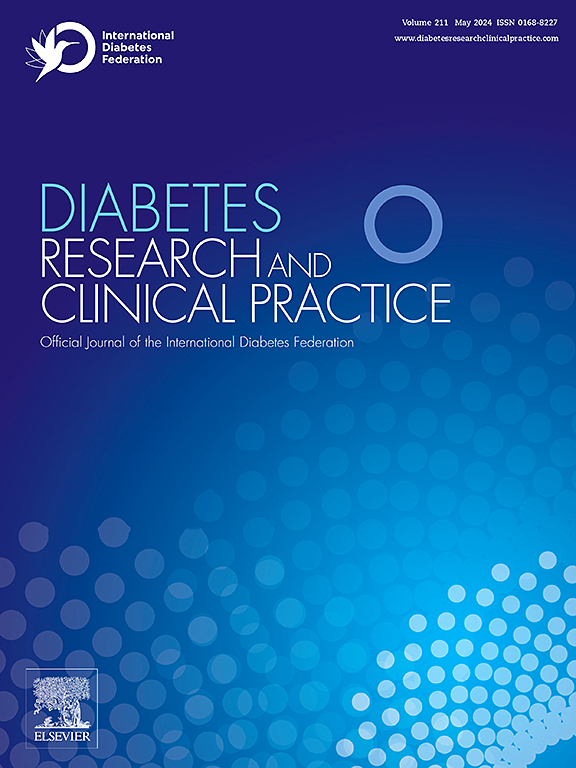使用机器学习预测2型糖尿病老年人糖尿病视网膜病变及其与痴呆风险的关系
IF 7.4
3区 医学
Q1 ENDOCRINOLOGY & METABOLISM
引用次数: 0
摘要
目的:糖尿病视网膜病变(DR)是糖尿病常见的微血管并发症,与痴呆风险增加有关。本研究旨在开发机器学习(ML)模型来预测DR的发生,并评估其作为痴呆症预后生物标志物的潜力。方法:我们纳入27,929例年龄 ≥ 50 岁的新诊断为2型糖尿病且既往无痴呆或眼病的患者。使用三种ML算法开发了一年内DR的预测模型:极端梯度增强(XGBoost),随机森林和最小绝对收缩和选择算子。表现最好的模型在8个机构中进行了外部验证。研究人员对患者进行了为期三年的随访,以评估痴呆症的发病率。使用Kaplan-Meier和Cox回归比较ml预测的DR组和非DR组的痴呆风险,并通过荟萃分析汇总结果。结果:XGBoost效果最佳(AUROC: 0.746),外部验证AUROC范围为0.555 ~ 0.620。预测DR与全因痴呆风险增加(HR: 1.32, 95%可信区间[CI] 1.12-1.56)、阿尔茨海默病(HR: 1.30, 95% CI 1.07-1.58)和血管性痴呆(HR: 1.38, 95% CI 1.12-1.69)显著相关。结论:ml预测的DR与未来痴呆显著相关,突出了其在糖尿病患者早期风险分层中的价值。本文章由计算机程序翻译,如有差异,请以英文原文为准。
Prediction of diabetic retinopathy using machine learning and its association with dementia risk in older adults with type 2 diabetes mellitus
Aims
Diabetic Retinopathy (DR), a common microvascular complication of diabetes, has been associated with an increased risk of dementia. This study aimed to develop Machine Learning (ML) models to predict DR occurrence and evaluate its potential as a prognostic biomarker for dementia.
Methods
We included 27,929 patients aged ≥ 50 years newly diagnosed with type 2 diabetes mellitus without prior dementia or eye disease. Prediction models for DR within one year were developed using three ML algorithms: extreme gradient boosting (XGBoost), random forest, and least absolute shrinkage and selection operator. The best-performing model was externally validated across eight institutions. Patients were followed for three years to assess dementia incidence. Dementia risk between ML-predicted DR and non-DR groups was compared using Kaplan-Meier and Cox regression, with results pooled via meta-analysis.
Results
XGBoost demonstrated the best performance (AUROC: 0.746), with external validation AUROCs ranging from 0.555 to 0.620. Predicted DR was significantly associated with increased all-cause dementia risk (HR: 1.32, 95% confidence interval [CI] 1.12–1.56), Alzheimer’s disease (HR: 1.30, 95% CI 1.07–1.58), and vascular dementia (HR: 1.38, 95% CI 1.12–1.69).
Conclusions
ML-predicted DR was significantly associated with future dementia, highlighting its value in early risk stratification among patients with diabetes.
求助全文
通过发布文献求助,成功后即可免费获取论文全文。
去求助
来源期刊

Diabetes research and clinical practice
医学-内分泌学与代谢
CiteScore
10.30
自引率
3.90%
发文量
862
审稿时长
32 days
期刊介绍:
Diabetes Research and Clinical Practice is an international journal for health-care providers and clinically oriented researchers that publishes high-quality original research articles and expert reviews in diabetes and related areas. The role of the journal is to provide a venue for dissemination of knowledge and discussion of topics related to diabetes clinical research and patient care. Topics of focus include translational science, genetics, immunology, nutrition, psychosocial research, epidemiology, prevention, socio-economic research, complications, new treatments, technologies and therapy.
 求助内容:
求助内容: 应助结果提醒方式:
应助结果提醒方式:


